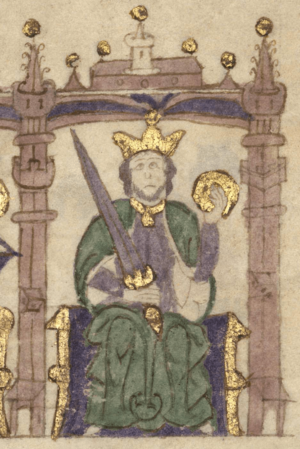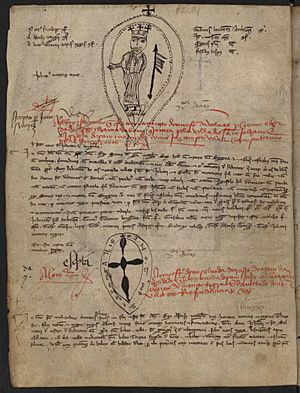Afonso II of Portugal facts for kids
Quick facts for kids Afonso II |
|
|---|---|

King Afonso in the Castilian manuscript Compendium of Chronicles of Kings, c. 1312-1325
|
|
| King of Portugal | |
| Reign | 26 March 1211 – 25 March 1223 |
| Predecessor | Sancho I |
| Successor | Sancho II |
| Born | Afonso Sanches 23 April 1185 Coimbra, Kingdom of Portugal |
| Died | 25 March 1223 (aged 37) Coimbra, Kingdom of Portugal |
| Burial | Alcobaça Monastery |
| Spouse | Urraca of Castile |
| Issue among others... |
Sancho II Afonso III Leonor, Queen of Denmark Fernando, Lord of Serpa |
| House | Burgundy |
| Father | Sancho I |
| Mother | Dulce of Aragon |
| Religion | Catholic |
Afonso II (born April 23, 1185 – died March 25, 1223) was the third king of Portugal. He was sometimes called the Fat or the Leper. Afonso was the oldest surviving son of Sancho I of Portugal and Dulce of Aragon. He became king on March 27, 1211, after his father passed away.
Contents
Afonso II's Reign as King
King Afonso II ruled Portugal in a new way. Before him, his father and grandfather focused a lot on wars. They fought against the neighboring Kingdom of Castile and the Moors in the south. Afonso II, however, chose a different path.
Peace and New Focus
Afonso II did not try to expand Portugal's land through war. Instead, he worked to keep peace with Castile during his time as king. Even without his direct military action, some towns were taken from the Moors. This happened because noblemen and church leaders took the initiative. For example, Bishop Soeiro Viegas led the effort to conquer Alcácer do Sal.
The first years of Afonso's reign were a bit difficult. He had some disagreements with his own brothers and sisters. But the king managed to keep Portugal safe and stable. He did this by making sure his relatives followed the laws, even if it meant sending them away.
Building a Strong Government
Since military issues were not his main focus, Afonso II worked on making the government stronger. He wanted to centralize power, meaning he wanted the main decisions to come from him. He created the first set of written laws for Portugal. These laws covered important topics like private property, how justice was handled, and how money was made.
Afonso also sent people to other European kingdoms. These ambassadors helped Portugal start friendly business relationships with many countries.
Challenges with the Church
One tricky area for Afonso II was his relationship with the Catholic Church. To get Portugal recognized as an independent country, his grandfather had given the Church many special rights. These rights made the Church very powerful, almost like a separate state within Portugal.
Afonso II tried to reduce the Church's power. He wanted to use some of the Church's large income for the good of the country. These actions caused a big disagreement between the Pope and Portugal. Pope Honorius III even removed Afonso II from the Church (called excommunication). Afonso II promised to fix things with the Church, but he died on March 25, 1223, before he could do so.
King Afonso was first buried at the Monastery of Santa Cruz in Coimbra. About ten years later, his body was moved to Alcobaça Monastery. This was what he had asked for in his will. He and his wife, Queen Urraca, are buried there in the Royal Pantheon.
Afonso II's Family
In 1206, King Afonso II married Urraca. She was the daughter of Alfonso VIII of Castile and Eleanor of England. Both Afonso and Urraca were related to King Alfonso VI of León.
Children with Queen Urraca
Afonso and Urraca had several children:
- Sancho II (born September 8, 1207 – died January 4, 1248), who became king of Portugal.
- Afonso III (born May 5, 1210 – died February 16, 1279), who also became king of Portugal.
- Eleanor (1211–1231), who became queen of Denmark.
- Ferdinand (1218–1246), who was the lord of Serpa.
Other Children
Afonso II also had two sons outside of his marriage:
- João Afonso (died October 9, 1234), who was buried at Alcobaça Monastery.
- Pedro Afonso (died after 1249), who joined his brother King Afonso in taking over Faro in 1249.
See also
 In Spanish: Alfonso II de Portugal para niños
In Spanish: Alfonso II de Portugal para niños


